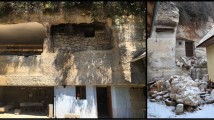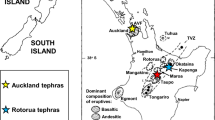Abstract
The aim of this study is to determine the extent of deterioration of the limestone on which the İvriz rock monument is engraved. This monument is near Aydınkent (İvriz) village and located 12 km from the Ereğli district of Konya. The height of the İvriz Hittite monument is 4.20 m and its width is 2.40 m. It dates back to the second-half of the eighth century BC. The rocks on which the reliefs are engraved are limestone; the lower parts are brecciated with open cracks, and the upper parts show fewer cracks with smaller gaps. To enable the identification of the characteristics of the rocks on which the figures are located, non-destructive methods were used. Surface humidity, P wave velocity, thermal imaging, and Schmidt hardness measurement were applied to the wall surface of the monument, and mapping studies were conducted. Surface humidity varied between 26 and 58% with the highest values measured in the sections where the cracks are densest. The P wave velocity measured at the rock monument varied between 1.6 and 5.8 km/s, with the lowest values found in the sections where cracks were denser. Schmidt rebound values varied between 18 and 42, with higher values obtained in those sections with fewer effects of deterioration. According to the detailed observations and data obtained from non-destructive techniques (NDT) and laboratory data, the most significant deterioration has resulted from atmospheric conditions and damage by humans. The most common effects of degradation in this area are erosion by water, granular disintegration, cracks, microkarst, black crust, biodegradation (lichen, algae, and higher plants), and vandalism.









Similar content being viewed by others
References
Akın M (2010) A quantitative weathering classification system for yellow travertines. Environ Earth Sci 61:47–61. https://doi.org/10.1007/s12665-009-0319-7
ASTM D5873 (2014) Standard test method for determination of rock hardness by rebound hammer method. Annual book of ASTM standards. American Society for Testing and Materials, West Conshohocken, pp 1–6
Bier L (1976) A second Hittite relief at Ivriz. J Near East Stud 35:115–126. https://doi.org/10.1086/372471
Casula G, Fais S, Ligas P, Mora P (2007) Experimental application of 3-D terrestrial laser scanning and acoustic techniques in assessing the quality of stones used in monumental structures. In: 4th international conference on NDT, Crete-Greece, 11–14 October 2007. pp 118–122
Christaras B (1996) Non-destructive methods for investigation of some mechanical properties of natural stones in the protection of monuments. Bull Int Assoc Eng Geol 54:59–63. https://doi.org/10.1007/BF02600697
Christaras B (1997) Estimation of damage at the surface of stones using non-destructive techniques. WIT Trans Built Environ 26:121–128
Christaras B, Cuccuru F, Fais S, Papanikolaou H (2015) Application of non-destructive ultrasonic techniques for the analysis of the conservation status of building materials in monumental structures. In: GD LG, Marunteanu C, Christaras B, Yoshinori I, Margottini C (eds) Engineering Geology for Society and Territory, vol 8. Springer, Cham, pp 139–143
Clark MR, McCann DM, Forde MC (2003) Application of infrared thermography to the non-destructive testing of concrete and masonry bridges. NDT E Int 36:265–275. https://doi.org/10.1016/S0963-8695(02)00060-9
De Beer J (1967) Subjective classification of the hardness of rocks and the associated shear strength. Paper presented at the Proceedings of the fourth regional conference for Africa. Soil mechanics and foundation engineering, Cape Town
Deere DU, Miller R (1966) Engineering classification and index properties for intact rock. Illinois Univ At Urbana Dept Of Civil Engineering, New Mexico
Demirtasli E, Turhan N, Bilgin A, Selim M (1984) Geology of the Bolkar mountains. In: geology of the Taurus belt. International symposium, 1984. pp. 125–141
Dinçol B (1994) New archaeological and epigraphical finds from Ivriz: a preliminary report Tel Aviv. J Ins Archaeology Tel Aviv Univ 21:117–128. https://doi.org/10.1179/tav.1994.1994.1.117
Fais S, Cuccuru F, Ligas P, Casula G, Bianchi MG (2017) Integrated ultrasonic, laser scanning and petrographical characterisation of carbonate building materials on an architectural structure of a historic building. Bull Eng Geol Environ 76:71–84. https://doi.org/10.1007/s10064-015-0815-9
Fitzner B, Heinrichs K, La Bouchardiere D (2002) Damage index for stone monuments. Paper presented at the 5th International Symposium on the Conservation Of Monuments in the Mediterranean Basin, Seville, 5-8 April 2000
Fookes PG, Dearman WR, Franklin JA (1971) Some engineering aspects of rock weathering with field examples from Dartmoor and elsewhere. Q J Eng Geol Hydrogeol 4:139–185. https://doi.org/10.1144/gsl.Qjeg.1971.004.03.01
Fort R, Alvarez de Buergo M, Perez-Monserrat EM (2013) Non-destructive testing for the assessment of granite decay in heritage structures compared to quarry stone. Int J Rock Mech Min Sci 61:296–305. https://doi.org/10.1016/j.ijrmms.2012.12.048
Hatır ME, Korkanç M, Başar ME (2019) Evaluating the deterioration effects of building stones using NDT: the Küçükköy Church, Cappadocia region, Central Turkey. Bull Eng Geol Environ 78:3465–3478. https://doi.org/10.1007/s10064-018-1339-x
Hawkins JD (2000) Corpus of hieroglyphic Luwian inscriptions: inscriptions of the Iron Age vol 1. Walter de Gruyter, Berlin
Heinrichs K, Fitzner B (2007) Stone monuments of the Nemrud Dag sanctuary/Turkey–petrographical investigation and diagnosis of weathering damage. Z Dtsch Ges Geowiss 158:519–548
Hoła A, Matkowski Z, Hoła J (2017) Analysis of the moisture content of masonry walls in historical buildings using the basement of a medieval town hall as an example. Procedia Eng 172:363–368. https://doi.org/10.1016/j.proeng.2017.02.041
ICOMOS-ISCS (2008) International council on monument and sites-international scientific committee for stone, Illustrated glossary on stone deterioration patterns. Champigny/Marne, France, Ateliers 30 Impresión
İnce İ, Bozdağ A, Tosunlar MB, Hatır ME, Korkanç M (2018) Determination of deterioration of the main facade of the Ferit Paşa Cistern by non-destructive techniques (Konya, Turkey). Environ Earth Sci 77:420. https://doi.org/10.1007/s12665-018-7595-z
ISRM (1981) Suggested methods: rock characterization, testing and monitoring. E. T. Brown (ed.), Pergamon Press, London, 211 pp.
ISRM (2007) The complete ISRM suggested methods for rock characterization, testing and monitoring: 1974–2006. In: Ulusay R, Hudson J (eds) Suggested methods prepared by the commission on testing methods. ISRM Turkish National Group, Ankara
Jo YH, Lee CH (2014) Quantitative modeling and mapping of blistering zone of the Magoksa Temple stone pagoda (13th century, Republic of Korea) by graduated heating thermography. Infrared Phys Technol 65:43–50. https://doi.org/10.1016/j.infrared.2014.02.011
Karauğuz G, Kunt H (2006) Ivriz kaya anıtları ve çevresi üzerine bir araştırma. Arkeoloji ve Sanat 122:23–50
Kilic G (2015) Using advanced NDT for historic buildings: towards an integrated multidisciplinary health assessment strategy. J Cult Herit 16:526–535. https://doi.org/10.1016/j.culher.2014.09.010
Korkanç M, Hüseyinca MY, Hatır ME, Tosunlar MB, Bozdağ A, Özen L, İnce İ (2019) Interpreting sulfated crusts on natural building stones using sulfur contour maps and infrared thermography. Environ Earth Sci 78:378. https://doi.org/10.1007/s12665-019-8377-y
Kramar S, Mladenović A, Pristacz H, Mirtič B (2011) Deterioration of the black Drenov Grič limestone on historical monuments (Ljubljana, Slovenia). Acta Carsologica 40. https://doi.org/10.3986/ac.v40i3.60
Maner Ç (2016) Preliminary report on the third season of the Konya-Ereğli survey (Keyar) 2015. Anatolia Antiqua Revue internationale d'archéologie anatolienne:225–252
Maner Ç, Menteş A (2018) An attempt of community archaeology in İvriz village: the role of archaeological heritage, during the process of rural regeneration and heritage conservation. TUBA-AR 23:227–240
Marsden S (2019) 24. Convention concerning the protection of the world cultural and natural heritage (World Heritage Convention). Yearbook of International Environmental Law 28:542–546 doi:https://doi.org/10.1093/yiel/yvy034
Merrill SOC (2011) Graffiti at heritage places: vandalism as cultural significance or conservation sacrilege? Time Mind 4:59–75. https://doi.org/10.2752/175169711X12893985693711
MGM (General Directorate of Meteorology) (2019) https://www.mgm. gov.tr/veridegerlendirme/il-veilceler-istatistik.aspx?m=KONYA
Mol L, Preston PR (2010) The writing's in the wall: a review of new preliminary applications of electrical resistivity tomography within archaeology. Archaeometry 52:1079–1095. https://doi.org/10.1111/j.1475-4754.2010.00516.x
NBG (1985) Engineering geology and rock engineering. Norwegian Group of Rock Mechanics. Fornebu, Norway
Price CA, Doehne E (2011) Stone conservation: an overview of current research, Second edn. Getty publications, Los Angeles
Roberts N (1983) Age, Palaeoenvironments, and climatic significance of Late Pleistocene Konya Lake, Turkey. Quat Res 19:154–171. https://doi.org/10.1016/0033-5894(83)90002-9
Robinson D, Williams R (1994) Sandstone weathering and landforms in Britain and Europe. In: Rock weathering and landform evolution, 1994. pp. 371–391
Şahin M (1999) Neue Beobachtungen zum Felsrelief von İvriz/Konya. Nicht in den Krieg, sondern zur Ernte: der Gott mit der Sichel. Anatol Stud 49:165–176. https://doi.org/10.2307/3643072
Seeher J (2009) Der Landschaft sein Siegel aufdrücken – hethitische Felsbilder und Hieroglypheninschriften als Ausdruck des herrscherlichen Macht- und Territorialanspruchs. Altorientalische Forschungen 36(1):119–139. https://doi.org/10.1524/aofo.2009.0006
Seyitoğlu G, Işık V, Gürbüz E, Gürbüz A (2017) The discovery of a low-angle normal fault in the Taurus Mountains: the İvriz detachment and implications concerning the Cenozoic geology of southern Turkey. Turk J Earth Sci 26:189–205
Siedel H, Siegesmund S (2014) Characterization of stone deterioration on buildings. In: Siegesmund S, Snethlage R (eds) Stone in architecture: properties Durability. Springer, Berlin, Heidelberg, pp 349–414. https://doi.org/10.1007/978-3-642-45155-3_6
Solla M, Asorey-Cacheda R, Núñez-Nieto X, Conde-Carnero B (2016) Evaluation of historical bridges through recreation of GPR models with the FDTD algorithm. NDT E Int 77:19–27. https://doi.org/10.1016/j.ndteint.2015.09.003
Topal T, Deniz BE, Güçhan NŞ (2015) Decay of limestone statues at mount Nemrut (Adiyaman, Turkey). Int J Archit Heritage 9:244–264. https://doi.org/10.1080/15583058.2013.768310
Tosunlar MB, Hatır ME, İnce İ, Bozdağ A, Korkanç M (2018) The determination of deteriorations on the Mısırlıoğlu bridge (Konya, Turkey) by non-destructive techniques (NDT). Iconarp Int J Archit Plann 6:399–412
TS 699 (2016) Natural building stones: methods of inspection and laboratory testing. TSE Publication, Ankara, pp 1–42
TS EN 12371 (2011) Natural stone test methods determination of frost resistance. TSE Publication, Ankara, pp 1–8
Turkington AV, Paradise TR (2005) Sandstone weathering: a century of research and innovation. Geomorphology 67:229–253. https://doi.org/10.1016/j.geomorph.2004.09.028
Acknowledgements
We would like to thank the Ministry of Culture and Tourism, Konya Provincial Directorate of Culture and Tourism, and Ereğli Museum Directorate for granting the necessary permissions to work in the field.
Author information
Authors and Affiliations
Corresponding author
Rights and permissions
About this article
Cite this article
Korkanç, M., İnce, İ., Hatır, M.E. et al. Atmospheric and anthropogenic deterioration of the İvriz rock monument: Ereğli-Konya, Central Anatolia, Turkey. Bull Eng Geol Environ 80, 3053–3063 (2021). https://doi.org/10.1007/s10064-021-02105-9
Received:
Accepted:
Published:
Issue Date:
DOI: https://doi.org/10.1007/s10064-021-02105-9




